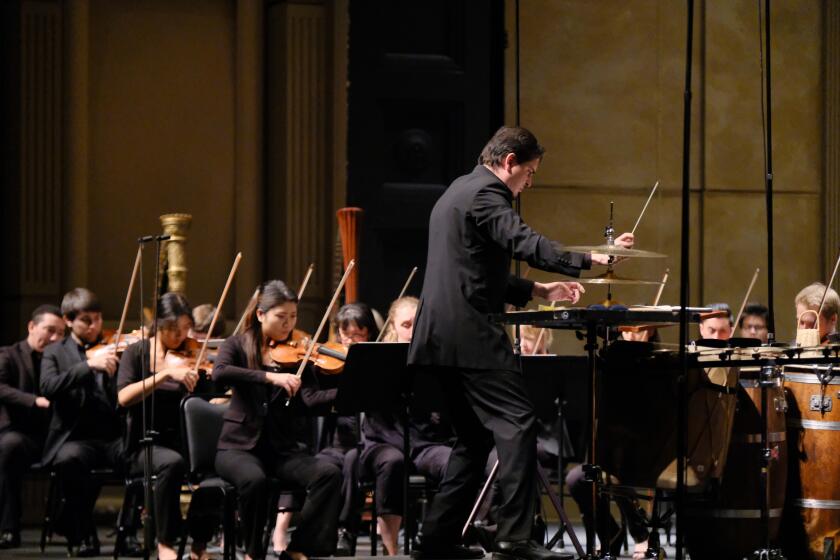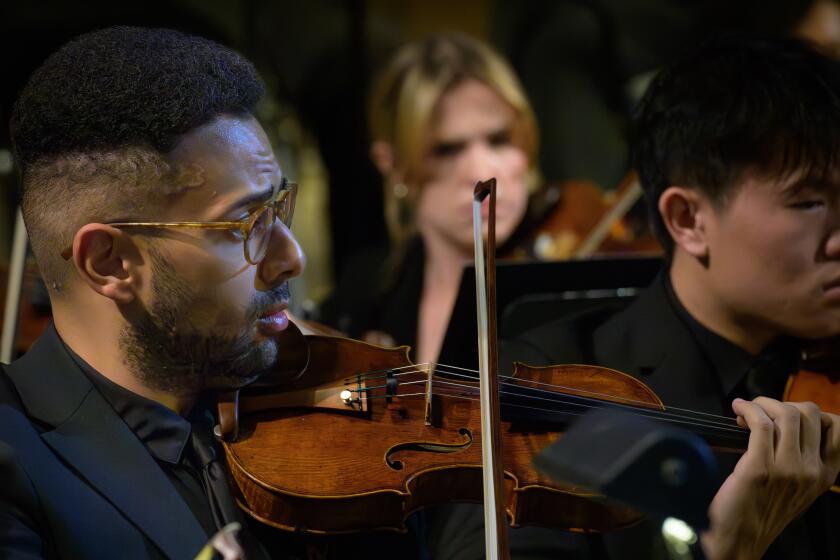The Anatomy of an Artist: A Mind-Body-Spirit Cliche
Kandinsky did it, Barnett Newman did it. To some extent, every artist since the first charcoal-wielding cave painter has probed the ineffable relationship between matter and spirit. Few have done it as garishly and theatrically as Alex Grey, whose work of the last 20 years is on view in an embarrassment of a show at the Museum of Contemporary Art, San Diego.
“Sacred Mirrors: The Visionary Art of Alex Grey” takes itself so seriously that it precludes anyone else doing so. In the history of art, the term “visionary” brings to mind characters like William Blake, whose brilliance and oddity fueled each other and made for a captivating body of work. Grey is no William Blake. His paintings look more like the stunted offspring of fantasist Frank Frazetta and New Age guru Deepak Chopra (who helped sponsor the show). They’re wildly radiant, intensely detailed, cosmically driven and eminently laughable.
The human body occupies center stage in Grey’s work, as living, pumping organism and seat of consciousness. Rendering skin translucent to reveal the network of muscles, arteries, organs and bones within, Grey exposes the body as the miracle it is, but he overexposes it to the point of visual exhaustion, suffocating any sense of mystery or awe. While celebrating the mind-body-spirit continuum, his images of couples in sexual embrace or a woman giving birth feel wrung dry of any real emotional charge.
Illustrative overkill plagues Grey’s work throughout. In the recent painting “Over-Soul,” a fiery matrix of eyeballs emanating from a body sums up the phenomenal workings of the senses and the soul. In “Painting” (1998), the artist stands at his easel, his eyes casting greenish beams of light onto the glowing canvas before him as he enacts a sci-fi version of artistic creation. Grey’s figures operate in a realm of raw energy, a pulsating, throbbing world of luminous auras, beams and rays, a world of such exaggerated special effects that the work verges on parody more than on profundity.
“Sacred Mirrors” (1979-89), a series of paintings within large, arch-shaped, sculptural frames, occupies one large gallery and forms the centerpiece of the exhibition. Through the 15 paintings, Grey tracks ascending levels of being, from the purely physical to the spiritually transcendent. An experienced anatomist, he renders the body’s various systems--circulatory, respiratory and so on--with precision, but when giving shapes and names to the shapeless and nameless drives within us, his diagrammatic style feels forced and superficial.
Grey draws on substantial traditions of mapping the body’s energy systems (as in acupuncture, for instance) as well as various religious traditions. In his quest to define what he calls a “metaphysical anatomy,” Grey, who is based in Brooklyn and has a long record as a performance artist, embraces diverse influences with holistic openness: a little Buddhism here, a touch of Hieronymous Bosch there.
That it all funnels down into such New Age cliches--a meditation room, spacey Muzak--is unfortunate, because the art world, not to mention the world at large, could use some powerful, life-affirming gestures as antidotes to the dark cynicism that passes these days as hip. But Grey’s work ends up being too kitschy to truly touch the spirit. For simpler, more incisive glimpses into the human condition, wander through the museum’s concurrent show of Lucian Freud etchings, unceremoniously installed nearby in the gallery that doubles as an auditorium foyer.
* “Sacred Mirrors: The Visionary Art of Alex Grey,” Museum of Contemporary Art, San Diego, 700 Prospect St., La Jolla, (619) 454-3541, through May 30.
More to Read
The biggest entertainment stories
Get our big stories about Hollywood, film, television, music, arts, culture and more right in your inbox as soon as they publish.
You may occasionally receive promotional content from the Los Angeles Times.






